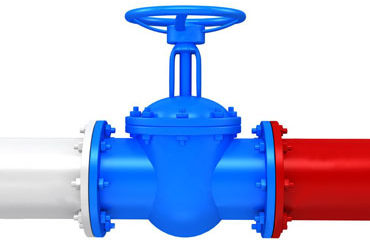
Common Questions about China Valve
Question 1: What is the Difference Between a Rising Stem and a Non-Rising Stem Gate Valve?
Function & Structure: Rising stem & Non-rising stem China Valve
Rising-stem and Non-rising-stem are both typically applied in gate valve design.
For the Rising-stem gate valve, the stem is fixed to the closure member(gate disc) and doesn’t turn with the operator but stays stationary with the gate. As the handwheel is turned, the threads of the stem, which are located above the packing box, retract the gate from the flow stream perpendicularly, causing the threaded portion of the stem to rise above the handwheel. The nut assembled between the handwheel and stem turns the handwheel’s rotational movement to the stem’s perpendicularly linear movement.
For a Non-rising-stem gate valve, the stem is threaded to the gate disc by using a nut. The gate moves up or down linearly along the stem while turning the handwheel. The stem has only rotational movement without up-and-down movement.
Differences between rising stem & non-rising stem gate valvesRising stems are often with outside screw & yoke (OS&Y) structure with the stem threads being isolated from the medium by stem packing while the threads of the non-rising stem are exposed to the medium. Therefore, the threads of the rising stem can be easily lubricated while the threads of the non-rising stem are more likely to be subject to corrosion and erosion. Workers at the site may easily tell the on/off status of a rising-stem gate valve by observing its stem position. A position indicator is required to show the open or close position of a non-rising stem gate valve. Non-rising stem gate valves are mainly used in services where limited space is inevitable. Besides, a non-rising stem gate valve is cheaper than a rising-stem gate valve in the same size, pressure rating, and material.
Question 2: What is the difference between the reduced bore and full bore valves?
The major difference between a full bore valve and a reduced bore ball valve is as below:
For the full bore valve, the bore diameter i.e hole in the ball has the same internal diameter as the pipe, whereas a reduced bore valve has a smaller bore diameter than the internal diameter of the pipework it is on. For example, the bore size in a 4-inch full-port ball valve is 4 inches in the internal bore, while the bore diameter in a reduced & standard ball valve is 3 inches in internal diameter.
Full bore ball valves are used where their low flow resistance is of value such as on pump suction pipes, where a pressure drop can affect pump performance. They are also used in flows containing mixed liquids and solids where flow restrictions can cause separations in the materials causing buildups and thus reducing the flow in the pipes. Standard(reduced)-port ball valves are used where pressure drop, turbulence in the flow, and material characteristics are not a concern. They also have the advantages of smaller size and lower cost.
If there is no strict demand on flow rate, you could select a standard(reduced) port as the price is more economic and the weight is relatively a little lower.
 Question 3: What Does CS ENP Standard for?
Question 3: What Does CS ENP Standard for?
ENP Ball- the trim of some ball valves is specified as “CS ENP 75 micron”. what do ENP and CS stand for?
CS- Carbon Steel ENP- Electroless Nickel Plated for china valve ball Sometimes, the industrial valve body (such as ball valves, globe valves, and wafer check valves )is ENP plated for the following reasons.
The function of ENP for Valve Ball of Ball Valves.
Corrosion resistance The most widespread application of electroless nickel technology is to provide superior corrosion protection in a multitude of corrosive environments. ENP acts as a barrier coating that protects by providing a pore-free barrier coating against the corrosive environment. This is in direct contrast to sacrificial films such as zinc or zinc alloy that protect the base material by sacrificing itself.
Deposit hardness Deposit hardness is one of the key topological properties of ENP coating technology. Factors that affect hardness are the film composition (%P), the heat treatment temperature, and the heat treatment time. Typical micro-hardness values for the as plated ENP deposits range from 500 to 720 VHN (Figure 8.) This is in contrast to electronically deposited nickel, which has typical values of 150-400VHN.
Wear resistance Electroless Nickel Phosphorus coatings are specified for a wide variety of engineered applications related to wear resistance. This is mainly attributed to the fact that the coatings not only have high hardness and intrinsic lubricity but also afford excellent corrosion resistance and deposit uniformity. The wear properties of ENP films can also be enhanced through the code position of inert particles such as PTFE, Silicon Carbide, or Boron Nitrite forming a composite coating.


 Question 3: What Does CS ENP Standard for?
Question 3: What Does CS ENP Standard for?
